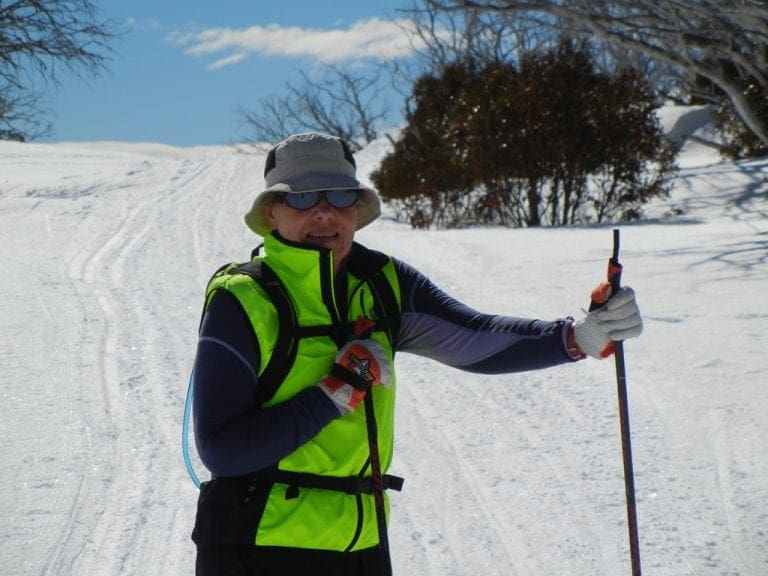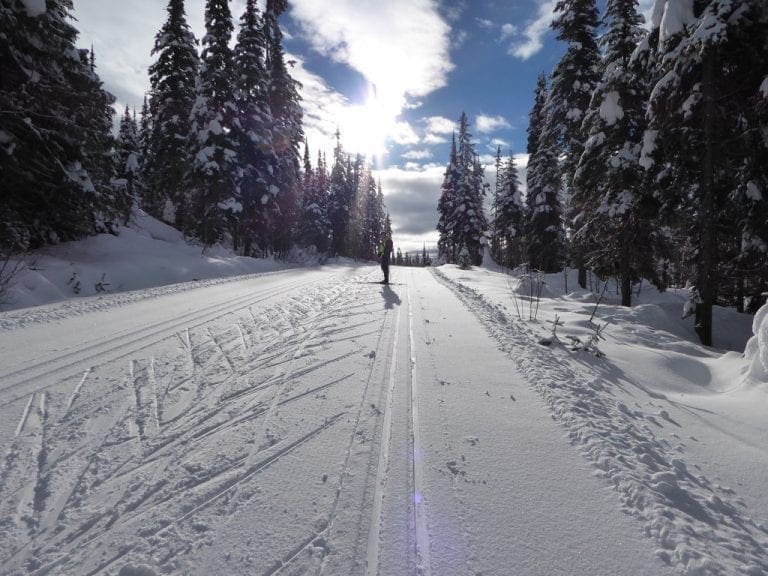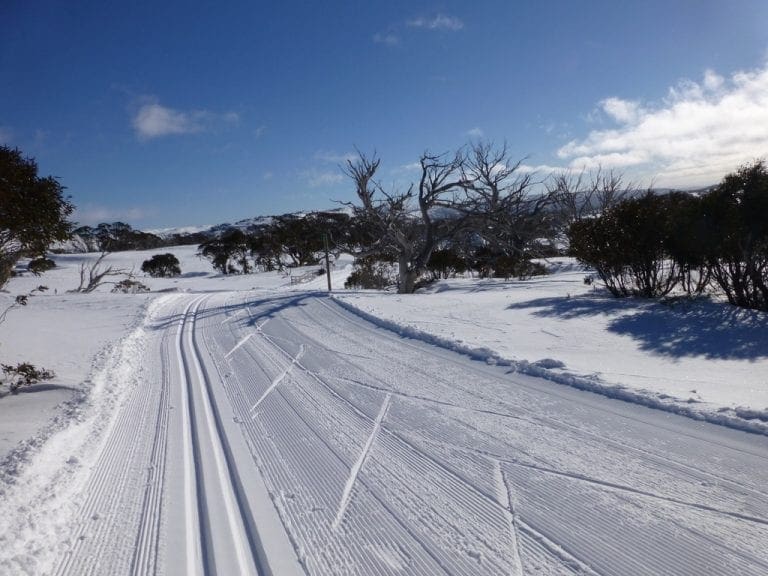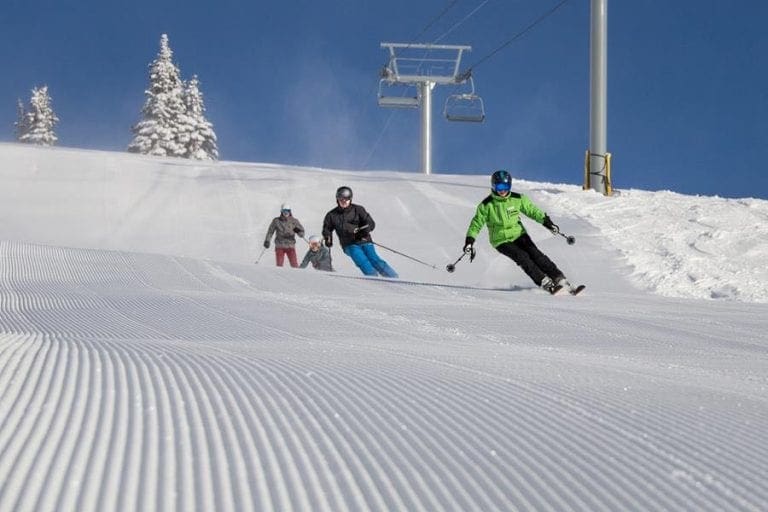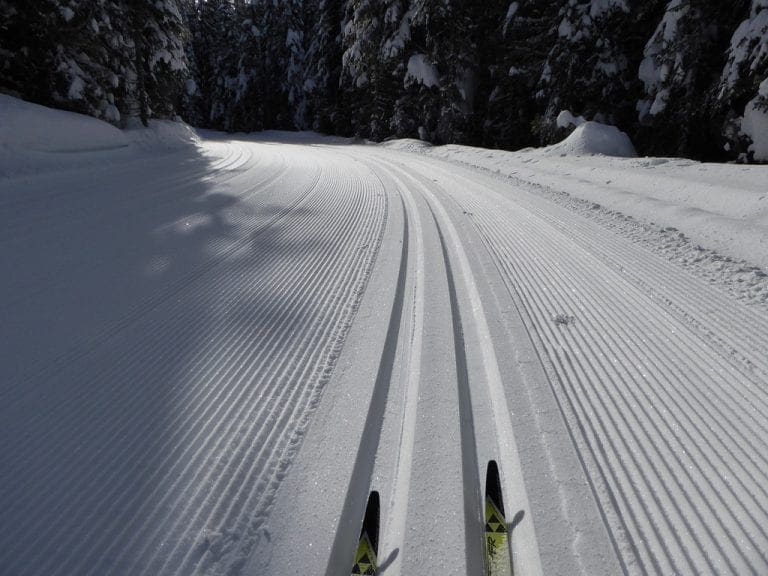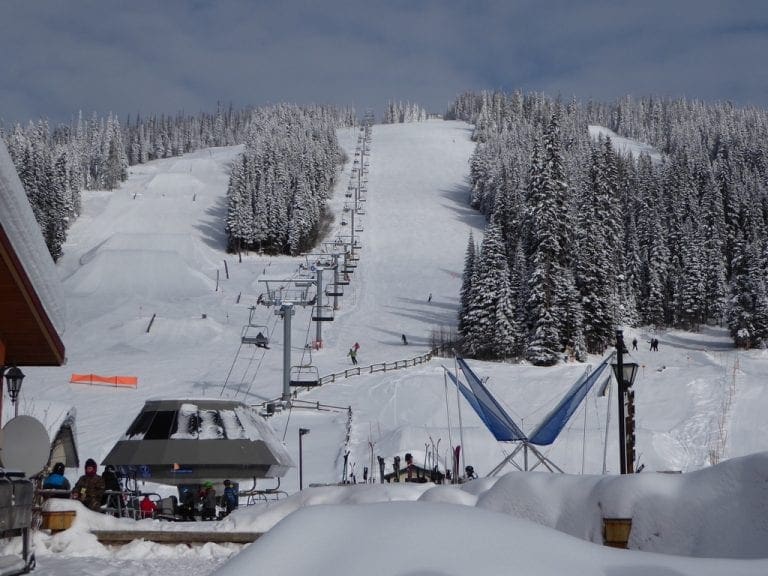Jindabyne August 2012
Day 2 Friday 24 August. It snowed heavily overnight. We drove up to Perisher. Heavy snow falling and covering the road from Saw Pit Creek. Very slow traffic clunking along with chains. About 3 cms covering the car park. We walked (with our skating skis) up to the Nordic Hut but nothing had been groomed and skating would not have been good in that very strong wind. We came back and had a leisurely day.
Day 3 Saturday 25 August. A lovely sunny day with a very light breeze. Chains needed from Wilson Valley. The 5 km and 2.5 km tracks were groomed, so we did both. Beautiful. Great grooming, fresh snow under a blue sky. I seemed to find skating a bit easier – my balance is better and I can stand up straighter. I think my better balance is because of the Body Vive balance and hip exercises and my intense ‘quad’ sets. We were the first on the new grooming of the 5 km. One fellow we met had managed to ski for 43 days this season. Way to go! Back to the cubby for lunch.
Day 4 Sunday 26 August. Another spectacular day – blue sky with a very light breeze. Chains needed from below Smiggins. The grooming had thickish drifts of wind-blown snow in parts that made skating difficult. The surprising thing is that we can do it. A couple of years ago, those exact conditions have had us give up because it was too hard. Today, we skated over the lot. (Well, almost the lot.) We did the 7.5km and the 2.5km tracks. We are using the same heart-rate control as we used last year. Skate 20 skates with each foot then stop until my heart rate drops below 140 Beats Per Minute BPM (For Helen, less that 130 BPM). Mostly, I get to 150 BPM after 20 skates. (This makes me think that except for very steep hills, each skate pushes my heart rate up by 0.5 BPM.) If the hill is very steep and I have had to use extreme offset skating, my heart-rate will get to about 160 BPM.
Day 5 Monday 27 August. Yet another spectacular day – blue sky no wind. Frost and -3C in the campground, frozen pipes and no water. No chains needed. 2.5, 5 and 7.5 km tracks all groomed. A bit crusty early because of the frost. We left the Nordic Hut at 9:30 and skated the 7.5 km track. Beautiful. At about the 2 km marker we came across Frank a TAFE teacher from Mackay on cross country skis for the first time. Because of all our stops we were going at the same rate, so we stayed with him to help him down the ‘down bits’. He did very well. It was good for us too because we did not race around too quickly and did not wear ourselves out too much. I concentrated on planting my foot further forward in the skate and doesn’t that make a difference.
A bit about the Nordic Shelter. This Shelter is at the trackhead for all the tracks. It is a short walk (200m) up from the Perisher carpark past the fire brigade, ambulance and helipad. For many years we did not use it because we skied up from the car park. Mistake. A few years ago, we began to walk up carrying our skis and boots and change in the Nordic Shelter. Much better. That bit up from the car park is by far the worst part of the track and would wear us out and bugger up our day. We’ve also met many nice people in the Shelter. A very good community.
I’ve been thinking about ‘10,000 hours makes an expert’ at something and our skiing. We’ve been skiing since 1976. On Australian slopes, we came down 10 weekends each season for many years. Each of those weekends, we would have achieved 8 hours, ie about 80 hours for the year. We did that for at least 10 years, ie about 800 hours. Some time in the late 90s we realized that we were not improving enough, because we could not get our hours up, and so we began our annual trips to Canada. These we usually 5-6 weeks (say 30 days skiing) skiing 5 hours a day, ie 150 hours per year. Twelve years of that, ie 1,800 hours. Total so far, 2,600 hours. Hmm.
Compare that with someone who grew up in a snow-bound valley in Canada, who skied every day of winter since she was 3 years old, who might have achieved 10,000 hours by the time she was 13.
Day 6 Tuesday 28 August. A great day for skiing. Not as sunny as the last few days, but the snow was smooth and creamy. We skated the 7.5 km track – anticlockwise. The first time we have gone in that direction. We have always gone clockwise, the main reason lately has been that we did not think we could skate up that long hill. We did it!! A huge break though for us today. Just to explain. In downhill skiing, the main skill is to go down the hill. In classic cross country, the skills are about going across and up the hill, with some down hill. In skating, the main skill is to get up the hill; then get up the hill with good form and least effort; then, to maintain that form in face of exhaustion and variable snow conditions.
Day 7 Wednesday 29 August. Today was to be a day-off. We drove up anyway. Very windy. We have learned that the wind in the car park is not a good indicator of conditions on the track. It was windy though. The biathlon team was out being coached in target practice with their ‘electronic rifles’. We skated up the 5 km (anti-clockwise) almost to the high point but we driven back by the strong wind. So we dropped down a bit and practiced skating up a moderate pitch. By the time we descended, it had begun snowing. It snowed down to Wilson Valley.
Day 8 Thursday 30 August. Much a repeat of yesterday – but windier and snowier. Wind blown snow. We skated up to just below where we got yesterday, retreated and played on the same hill. Much more difficult today because of the stinging wind blown snow and snow drifts covering the track. Hard work, but we did it.
It snowed most of the way down the hill. An snowed in Jindabyne (920m) until mid afternoon. It looked heavy but was not enough to form on the ground.

